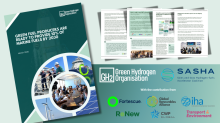Green Shipping Fuels
The decarbonisation of shipping requires the use of fuels produced with renewable energy. The Green Hydrogen Organisation works with governments, fuel producers, think tanks and international organisations to make this happen by advocating for green hydrogen and its derivatives as the pathway to truly clean maritime transport.
Through partnerships with progressive voices in the maritime space including University College London, the Rocky Mountain Institute, Global Maritime Forum, The Skies and Seas Hydrogen-fuels Accelerator (SASHA) Coalition, Transport and Environment, and United Nations High-level Champions, and by maintaining a working group with green maritime fuel producers, GH2 ensures their voices are heard in policy discussions that support robust frameworks favouring genuinely low-carbon alternatives over transitional options like LNG or crop-based biofuels.
The Green Hydrogen Organisation has published papers, blog posts and policy briefs highlighting green hydrogen and ammonia as credible zero-emission fuels for shipping.
Newsletters

IMO agrees first globally mandated emissions targets for shipping but more work needed

Are we heading towards shipping leadership on climate or fossil-fuel lock-in?

IMO at the crossroads, for green shipping and green fuels

IMO compromise proposal - a bridge to nowhere?

Hold the line on renewables and green hydrogen in Europe
Green fuels for a zero-carbon shipping sector
Maritime transport carries around 90% of global trade but is responsible for nearly 3% of global greenhouse gas emissions (more than Germany emits annually). Today, the sector relies heavily on heavy fuel oil, a high-emissions fossil fuel. To meet net-zero targets and avoid locking in transitional options like LNG or crop-based biofuels, the shipping industry must transition to truly clean alternatives. Green hydrogen and its derivatives, particularly green ammonia, can eliminate virtually all emissions from maritime transport. Maritime decarbonisation aligns with multiple UN Sustainable Development Goals, including climate action (SDG 13), ocean protection (SDG 14), clean energy (SDG 7), industrial innovation (SDG 9), and global partnerships (SDG 17).
The International Maritime Organization (IMO) has adopted a 2023 GHG Strategy aiming to reach net-zero emissions from international shipping by 2050. It calls for zero or near-zero GHG fuels to represent at least 5%, striving for 10%, of marine energy use by 2030. This would require approximately 32,5 million tonnes per annum (MTPA) of green ammonia by 2030, with 65 MTPA needed to hit the 10% mark. Green hydrogen producers are ready to deliver: as of 2024, 244 MTPA of clean ammonia projects had already been announced, more than the current global fossil-based production.
Yet the cost gap between green and fossil fuels remains a challenge. Green ammonia costs around $800 per tonne, and due to its lower energy density, ships consume about 2,5 times more by weight than heavy fuel oil. With carbon-intensive heavy fuel oil costing about $650/tonne and each tonne emitting roughly 3 tonnes of CO₂, a greenhouse gas (GHG) levy of $150/tCO₂ would make the fossil equivalent cost about $1.100 per tonne. To compete, green ammonia would require an incentive of roughly $360 per tonne. Without a robust carbon price, it remains cheaper to “pay to pollute.”
Green shipping and global leadership
The Green Hydrogen Organisation is working to ensure that green fuels have a central role in the future of maritime transport. In March 2025, GH2 and SASHA hosted the International Maritime Decarbonisation Roundtable in London to build momentum for green ammonia as a scalable, zero-carbon shipping fuel. In April, the International Maritime Organization agreed to the first globally mandated emissions targets for shipping. From 2028, ships will be required to cut emissions by 17 percent or pay a penalty of up to USD 380 per tonne of CO₂. While the final agreement includes credit trading and lower penalties for partial compliance, it marks a significant step forward for the recognition of near-zero fuels.
Green fuels will be able to generate tradeable credits, and the IMO has committed to deciding by 2027 how zero and near-zero emission fuels will be rewarded. These decisions provide greater investment clarity and send a strong signal that green ammonia will play a growing role in shipping. GH2 continues to advocate for emissions accounting that includes methane leakage and indirect land-use change, and for a policy framework that supports a just and equitable transition. With green fuel developers ready to supply 10 percent of global marine fuels by 2030, the shipping industry can accelerate its transition and avoid long-term reliance on fossil-based alternatives.



